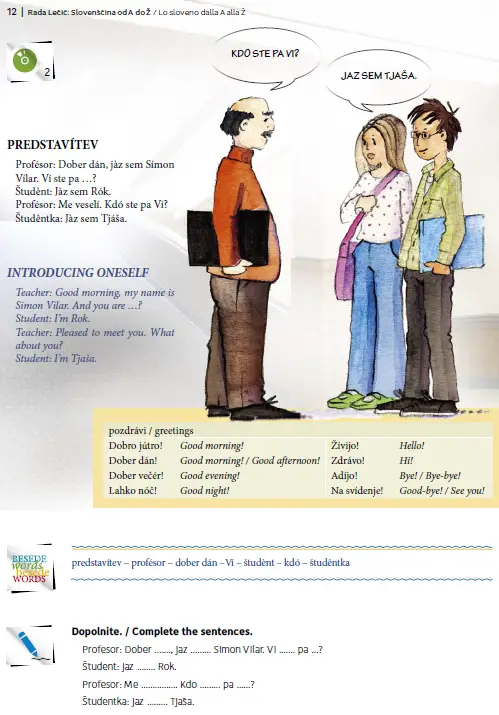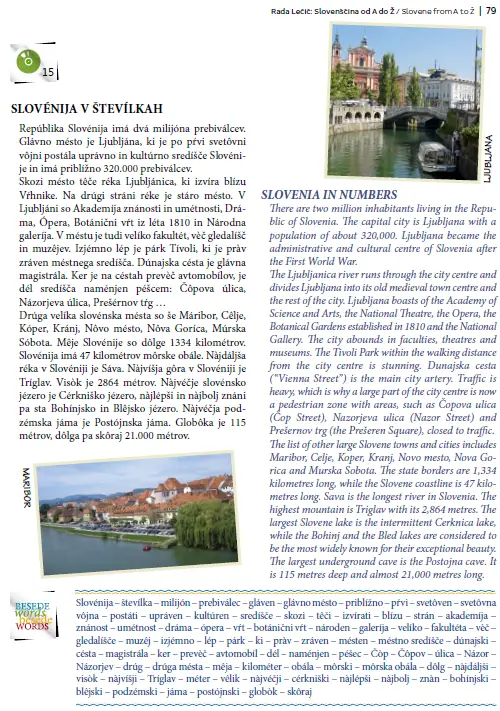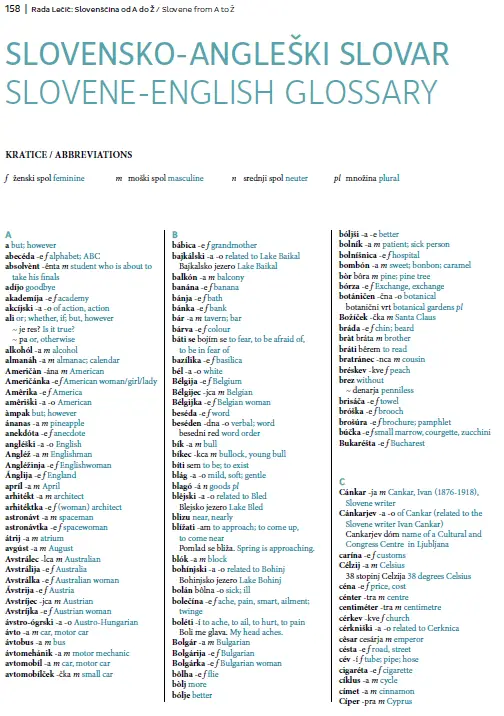Lifestyle
STA, 21 October 2020 - There were technical issues preventing some students from participating in remote learning when students from grade 6 switched top remote learning on Monday. The authorities say the kinks have now been ironed out and the system is robust enough even if all students switch to remote learning.
On Monday many students reported having problems logging into accounts that were set up specifically to access online classrooms run by the Academic and Research Network of Slovenia (ARNES), which provides internet infrastructure for educational and research institutions in Slovenia.
On Tuesday there were still some glitches with the online classrooms, while today ARNES witness two distributed denial of service (DDOS) attacks, at 8am, when most students were logging in, and again at 10am. The online classrooms were therefore unavailable for roughly 15 minutes, but both attacks were successfully deflected, ARNES said today.
ARNES director Marko Bonač provided assurances that the problems have been sorted out as he met with Education Ministry State Secretary Jure Gašparič today. "I hope it stays this way," he said.
Gašparič said the system was now "sufficiently robust and resilient" even if students from grades one to five of primary school were to switch to remote learning now.
Education Minister Simona Kustec expressed regret and said she expected the system will be stable in the future. "I hope that this was a beginners' mistake that will not happen again because it must not happen."
All our stories on coronavirus and Slovenia
STA, 21 October 2020 - Several violations were reported after a 9pm-6am Covid-19 curfew took effect on Tuesday, according to the Health Inspectorate. Several warnings were issued in Maribor, where a protest took place, and one minor offences proceeding was initiated. In Ljubljana ten warnings were issued.
A group of around 50 gathered in the central square in Maribor yesterday evening to protest the curfew. Maribor police said warnings were issued and one minor offences proceeding initiated. The crowd dispersed by 9:30pm.
In Ljubljana, ten warnings were issued.
Ljubljana police were also notified of a gathering of a larger group of persons in Fužine borough. A patrol car which arrived at the site asked for reinforcements, during which time several people started throwing items into the car.
The individuals dispersed before more patrol cars arrived at the scene. The police said the individuals could not be identified.
Compliance with the curfew is monitored by the Health Inspectorate along with the police. Fines for violations range from EUR 400 to EUR 4,000.
STA, 21 October 2020 - More than a dozen independent producers and non-governmental organisations face the threat of eviction from the state-owned premises in a former military compound in Metelkova Street in Ljubljana that witnessed some of the landmark events leading to Slovenia's independence.
Some of the NGOs that have their premises in the building received an appeal from the Culture Ministry on Monday that they move out by the end of January 2021 or face a court-imposed eviction.
The ministry says the building is in a bad state of disrepair and is slated for renovation, but the NGOs say that budget funds for the planned renovation are not planned until 2023 and are refusing to leave.
The NGOs say the ministry has not offered them substitute premises or engaged in dialogue with them, which is why they understand the move as an "attack on civil society and independent culture in the desire to prevent the activity of a critical public".
The building is home to several internationally renowned independent producers and organisations active in cultural and artistic production, research and advocacy of minority and marginalised groups, including the Peace Institute, Zavod Maska, Škuc, the producers of City of Women and Kino Otok film festival, dance company PTL, and the arts collective NSK.
In a press release on Tuesday, the organisations noted that their work can be traced back to the legacy of the movements that "in the 1980s promoted the society's democratisation and demilitarisation, thus decisively contributing to the adoption of a democratic constitution after independence".
The compound was where Janez Janša, the incumbent prime minister, was detained by the Yugoslav army in 1988 before being put on trial by the military for allegedly divulging a military secret in a newspaper article, along with three other defendants in what is known as the JBTZ process.
The quartet's arrest and subsequent trial triggered massive protests and acted as a catalyst for Slovenia's democratisation and independence.
One of the key symbolic events in the efforts for democratisation and demilitarisation as pointed out by the NGOs was in 1993 when culture workers, artists and activists occupied what used to be the Yugoslav army's Ljubljana headquarters.
"Ever since it has constituted a public space where we respect diversity, solidarity, dialogue and critical thought. Those values and historical facts are what the current government seeks to erase, even though the prime minister used to count himself among pacifists," the NGOs say.
They say the building in Metelkova 6 is the only one that the Culture Ministry has allocated to independent cultural, artistic and research organisations working in the interests of the public, but that the ministry chose to "withdraw our basic infrastructure amid the pandemic".
The building is the only part of the south section of the Metelkova compound that is yet to be renovated. Owned by the Culture Ministry, the section is home to three museums and several other cultural institutions.
The north section of the compound, known as AKC Metelkova Mesto, has developed into an alternative culture hub after being squatted by artists in the early 1990s as the city authorities, which assumed ownership of that part of Metelkova, started pulling down the buildings. The former military prison has been turned into a hostel called Celica.
The NGOs insist that they will "not leave the building and will stand up full force against attacks on the civil society, independent culture and democracy".
In response for the STA, the Culture Ministry said the building concerned was unsafe to reside in: "The main structure is undermined, the roof is leaking, part of the roofing has fallen off and damaged a car in the parking lot."
The ministry noted that the building, which is not earthquake safe, had been planned for urgent renovation under the previous government, and to avoid any risk it urged the 18 users to move out so the building could be refurbished.
The ministry said that none of the users of the building have been paying rent and that some have not even paid for their running expenses.
The NGOs facing eviction have been backed by the centre-left opposition, in particular the Left, and an online petition signed by more than 2,300 people, which accuses the government of "trying to destroy the cultural sector, and in particular NGOs".
STA, 21 October 2020 - Galleries, museums, archives and libraries will be the only cultural venues that are allowed to provide in-person services to visitors in most of Slovenia from Thursday, as changes to the respective government decree come into force.
The decree limiting the offering and sale of goods and services to consumers due to the coronavirus epidemic was amended by the government in a correspondence session late on Tuesday in accordance with its previous announcements.
The changes apply to regions in which the rolling 14-day average of new coronavirus cases has exceeded 140 per 100,000 residents, which means all but the south-western region of Obalno-Kraška (currently at 100.9).
The ban is being extended from night clubs, which have not been allowed to reopen since the start of the epidemic in spring, to cinema theatres and cultural institutions, with the exception of galleries, museums, archives and libraries.
Skladno z novimi vladnimi ukrepi v Kinodvoru od danes ni projekcij. Zaprti sta tudi Kavarna in Knjigarnica.
— Kinodvor (@kinodvor) October 16, 2020
Kupljene vstopnice za odpovedane projekcije bo možno zamenjati za projekcije istega filma, ko bomo določili nov datum, oz. vračilo denarja, ko bo blagajna spet odprta. pic.twitter.com/FiIYNp401D
However, like other in-person businesses that remain open, they are required to follow the rule of one customer per 20 square metres.
The rule, which applies to stores and various offices and other public indoor spaces, is now being extended to hair and beauty salons, after the government initially limited them to one customer per salon.
However, if the premises are smaller than 20 square metres only one customer is allowed inside at a time.
Meanwhile, gyms remain closed in red-coded region, while the one customer per 20m2 applies to gyms in the sole orange-codded region.
The serving of food and drinks in hospitality establishments remains banned in red regions, except for takeaway and delivery services, while bars, cafes and restaurants in the Obalno-Kraška region can continue to serve customers at the tables between 6am and 9pm, provided a distance of at least 1.5 metres between customers that are not members of the same household.
Under the same conditions hospitality services are allowed in accommodation facilities in all regions, regardless of their coronavirus status. Hotels are allowed to remain open in as much they strictly follow coronavirus precaution standards.
Presenting measures at a press briefing on Wednesday, Economy Minister Zdravko Počivalšek said the government was "doing all in our power to allow a semblance of normal life to continue", but that further measures would depend on the epidemiological status.
Slovenia saw a new surge in daily infections as the total case count increased by 1,503 on Tuesday to 15,983, of which 8,861 remain positive, and the death toll rose by eight to 200.
All our stories on coronavirus and Slovenia
At the British International School of Ljubljana staff, parents and pupils have started the transition to online learning, following the new government measures in effect from Monday 19th October. This transition for students to follow a full timetable of lessons online each day is just one of the stages that have been implemented by the school since the academic year started at the end of August 2020.
As with many schools, a thorough and detailed five-stage strategic plan had been created to enable the students to continue receiving a high-quality provision of education should there be an increase in Coronavirus cases.
This plan included working closely with parents, staff and students to gather feedback, further enhancing onsite and online safety procedures, providing exciting online courses, developing the staff with a range of training opportunities, and then planning a seamless transition for students from the physical classroom to an online environment. The school has also set up regular communication routines to celebrate student achievement, support individuals with their work, and to keep parents up to date with any advice or changes to guidance.
The online lessons include not just the academic classroom-based subjects such as English and Mathematics, but a full schedule of Performing and Visual Arts, Physical Education and Languages for the students to attend and enjoy.
A typical day might include English, Mathematics, and Slovene lessons before break, then Geography, Art and a Physical Education class with theory followed by a keep-fit session with all students actively involved before lunch, finishing the online school day with Music and Form time where students can reflect on their day with the support of their Form Tutor. During this time, both physical and mental wellbeing are very important as students seek a balance between schoolwork and healthy living. The students start the day with a brief video meeting with their Form Tutor for any urgent announcements, helpful organisation tips and group activities to complete before the online lessons begin. This is an effective use of time to bring the students together, support with any concerns, and set a positive tone for the during this challenging time.
The students have thus far been incredibly mature, upbeat and receptive during the transition to online learning, and with a familiar timetable in place, the students can attend all classes online, revisit activities to consolidate learning or challenge themselves further to stretch ahead and learn more. The lessons observed so far have had a real ‘buzz’, interest and excitement as many of the students are helping each other and continuing to develop their own technological expertise. For parents, all curriculum plans are readily accessible, allowing them to see a complete overview of the units that the students will cover for the entire academic year, for every year group and every subject.
The Principal, Mr Paul Walton, commented, “We are very proud of the strategic plan we put in place from May 2020 when we returned to the school premises, we are now seeing the significant impact of all of the effort by our dedicated and passionate teachers. Although initially this can be seen as extra work to improve policies, attend training sessions, and develop innovative online content, we can now see first-hand how the students are benefiting from this forward-thinking approach. It has also been a pleasure to support and share best practice with other schools here in Slovenia, as we are all working towards the same goal, I have been delighted to be able to contribute to this.”
In school, all events are held online, including a recent virtual coffee morning with the Principal, and useful workshops for parents to equip them with the tools to support their child’s learning at home further. Recordings of online events are then sent out to parents with further information. They continue to follow the highest standards of hygiene and health and safety guidelines for the students and staff who continue to work in the building.

Positive feedback from our families at school reacting to the online learning transition and our communication.
In relation to this, during Thursday 15th October, the school had its Ministry of Education visit as part of the nationwide checks on schools. It received a 100% compliance result, including no further targets or areas to improve. It included an interview with the Principal, a comprehensive check on policies, procedures and security, a tour of the site, visits to classrooms, checks of safety measures, signage/instructions for students to follow and other important preventative measures that schools are following during this time. With the small class sizes at the British International School of Ljubljana, impressive quality of teaching and personalised learning methodology, they are able to create a very positive and safe environment for students to learn in.
The school has already received a large number of positive comments and encouraging feedback from parents on how the online provision has been set up, communicated swiftly and the ease of which the transition was handled.
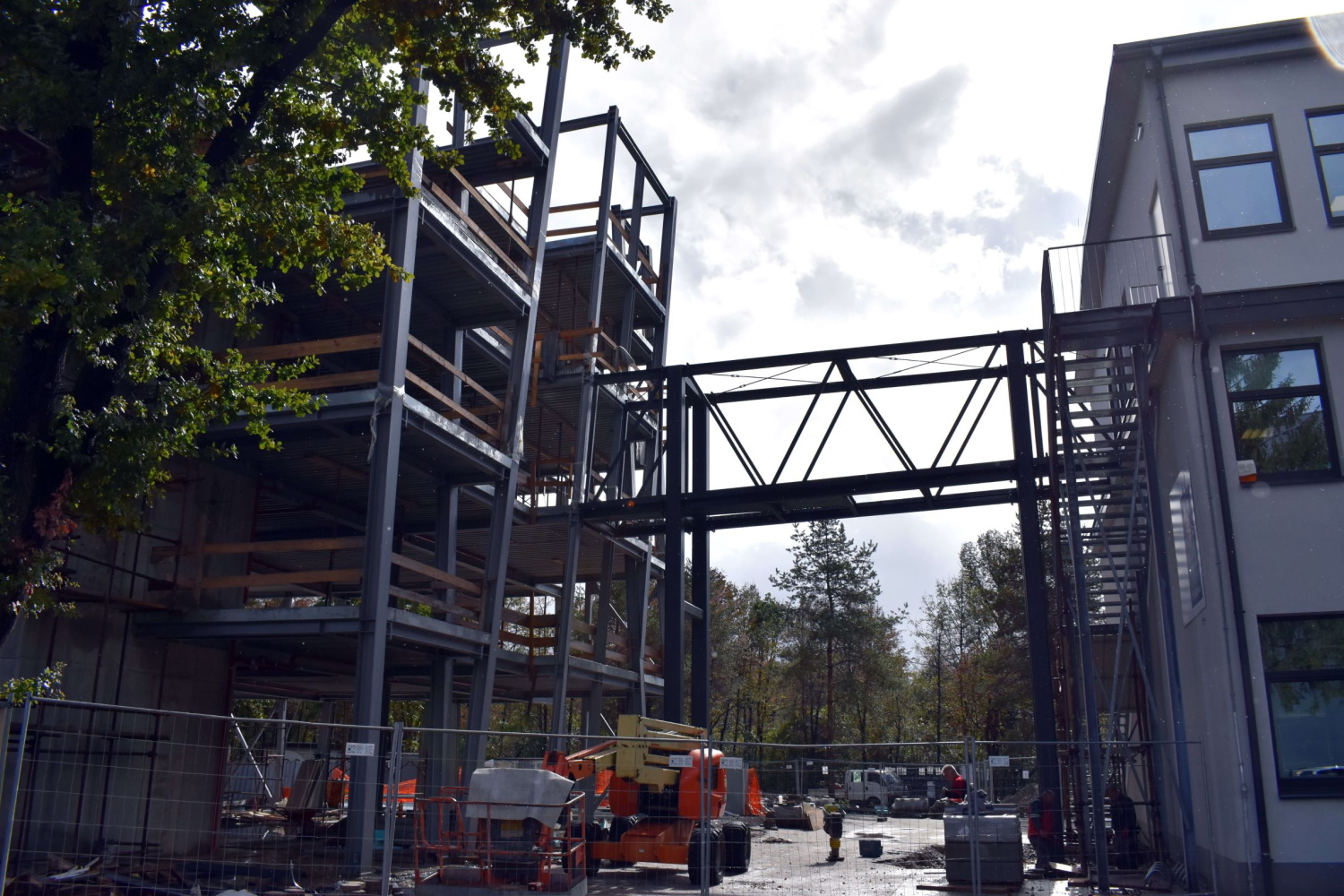
The bridge connecting the two buildings is already visible and this new project will be a wonderful showcase entrance to the school building.
Along with the developments in online learning, the school continues to grow with its new additional building progressing extremely well. The new building will include a range of outstanding facilities to enhance the pedagogical opportunities offered for its students, such as a performing arts theatre with six sound proofed adjoining practice rooms, a robotics lab, computer suite, new library and large specialist classrooms. The bridge connecting the two buildings is already visible and this new project will be a wonderful showcase entrance to the school building.
The British International School of Ljubljana benefits from being part of the Orbital Education Group, where there is a continued focus on offering a provision of high-quality education across all the schools. Find out more about the British International School of Ljubljana here.
Finally, the British International School of Ljubljana is hosting a Virtual Open Day for prospective families at 10am on Tuesday November 17 - find out more here if you are interested in joining the event.
STA, 21 October 2020 - A record 1,503 Sars-CoV-2 infections were confirmed in Slovenia on Tuesday, up considerably from the previous daily high of 898, recorded on Friday, as the test positivity rate exceeded 25%, show the latest official data. In the deadliest day yet, eight Covid-19 patients died, raising the death toll to 200.
Covid-19 hospitalisations rose by 20 to 333 despite 32 patients being discharged yesterday. The number of Covid-19 patients in intensive care decreased by one to 55, but the number of those being mechanically ventilated increased by three to 41.
Presenting the latest figures at a press briefing that moved fully online, government spokesman Jelko Kacin said that 5,891 tests had been performed on Tuesday, which means the positivity rate hit 25.5%.
He said that new local virus hotspots were appearing across the country, in particular in the north-western region of Gorenjska, which has the highest incidence rate at the moment.
Data from the tracker site covid-19.sledilnik.org show that the latest cases bring the number of currently active cases to 8,860 and the total case count to 15,982. The rolling 14-day average per 100,000 residents has increased to 423.
The new surge comes after a series of new restrictions have come into effect, including a 9pm-6am curfew last night. Kacin said that while a great majority understood and abided by the measures, some individuals would not and would not help.
This was after a group of protesters gathered in Maribor late last night to demonstrate their opposition to the curfew. PM Janez Janša responded with a tweet in which he revealed that the number of new cases had already surpassed 1,100 and urged the protesters to "get serious".
Kacin, as well as Tatjana Lejko Zupanc, the head of the Infectious Disease Department of the Ljubljana UKC hospital, Slovenia's main Covid-19 facility, appealed on everyone to say at home as much as possible, and urged employers to enable their employees to work from home whenever possible.
However, Lejko Zupanc did not answer in the affirmative when asked whether she thought public life should be brought to a halt completely, noting that it had stopped in a way and that a shutdown of kindergartens, for example, would affect health staff, which was badly needed.
Asked whether Slovenia was reaching a point seen in Italy in spring when doctors would have to chose whom to treat as a priority, Lejko Zupanc said: "We're far from being there, and we'll prevent that if we can (...) I hope and believe we won't reach that point."
The official said the UKC Ljubljana medical centre was working on securing extra beds to cope with the expected influx in Covid-19 patients requiring hospital treatment. With the expansions, UKC Ljubljana will have 40 to 50 intensive care beds and 170 regular hospital beds, which should do to weather the crisis.
She said the medical centre had capacities for further expansion if needed, but a bigger problem was staff. Final year medical students, volunteers and retired health staff have been asked to help alleviate the burden on overworked staff, and staff reassignments between departments are planned.
Lejko Zupanc revealed that five children with Covid-19 were being treated at UKC Ljubljana and 92 adults. Twenty one are receiving intensive care, and most of them are on ventilators.
According to the Jožef Stefan Institute (IJS), Slovenia's reproduction number, showing how many people one infected person will pass the virus on to, has climbed to 2.18, while the epidemic has been spreading with a doubling time of 6.2 days.
The institute estimates that 1.5% of the population is currently infected or one in 70 people, and the share is rising fast.
In the first wave, about 1% of the people got infected. At the peak of the first wave 0.35% of the population was infected or one in 300 people.
In the second wave, 2.5% of the people have been infected so far or one in 40 people. In total, 3.5% of Slovenians have caught the virus so far or one in 30 people.
The IJS expects the measures introduced at the end of last week to start having an impact at the end of the week, while the measures that the government adopted on Tuesday should show next week.
All our stories on Slovenia and coronavirus. The latest statistics on coronavirus and Slovenia, and the latest police news on red, green and yellow list countries. All our stories on coronavirus and Slovenia. Can I transit Slovenia? Find out from the police...
STA, 20 October 2020 - Slovenia has more than 6,000 towns and villages, many of them named after animals or plants, like Mačji Dol or Kostanj, translating to Cat Vale and Chestnut. Some 4,800 places have unique names, while other names are quite common, such as Šolska Ulica (School Street), the Statistics Office has said, adding that Slovenia has both Eden and Hell.
The latter refers to the villages of Paradiž, located in the remote and placid hills of Haloze in the east, and Pekel, a hilly village just north of Maribor, strewn with vineyards and nearly encircled by two Maribor motorways.
While most names occur only once, some are very common. Šolska Ulica, for example is the most common of 10,000 street names, as 52 towns have their own School Street. Prešernova Ulica, named after the Romantic poet France Prešeren, the author of the national anthem, is the second most common street name, used 45 times.
Many names reflect a connection with the animal world: Konj (Horse), Ježevec (Porcupine), Lisjaki (Foxes), Srnjak (Stag), Petelinje (Rooster's), Zajčji Vrh (Hare Peak), Žabja Vas (Frog Village), Medvedjek (Bear's), Jelendol (Deer Dale) and Kačji Dol (Snake Vale), among many others.
Interestingly, there is no Mačja Ulica (Cat Street) in Mačji Dol (Cat Vale), the Statistics Office said.
Many place names suggest a relation with plants, including Breza (Birch), Jablana (Apple Tree) and Šipek (Rosehip).
But not all have necessarily been named after plants or fruits. According to the Etymology Dictionary of Slovenian Geographical Names, Borovnica (Blueberry) and Maline (Raspberries) were not named after the respective berries, the Statistics Office says.
Many places carry personal names, often those of saints, including Lucija, Florjan, Marjeta, Štefan, Primož and Benedikt.
Others, especially villages, have names that are unusual even to Slovenians, either because they are tongue twisters such as Kokolajnščak, Bolehnečici or Podpulfrca, or because of unusual semantics, such is the case with Bruhanja Vas (Vomit Village) and Ritoznoj (Butt Sweat).
STA, 20 October 2020 - The number of new coronavirus infections continues to rise in Slovenia, reaching 794 on Monday, when 4,326 tests were conducted. Currently, 313 Covid-19 patients are in hospital, including 56 in intensive care, the government said on Tuesday. Two more people died, bringing the death toll to 192.
A total of 38 patients are mechanically ventilated and 27 patients were discharged from hospital, while 53 new patients were admitted, according to data by the tracker Covid-19.Sledilnik.
So far, 14,472 infections have been confirmed in Slovenia in 293,769 test, with 7,708 currently active cases. The country saw 368 new cases per 100,000 people in the last 14 days.
As the number of admissions rises, hospitals around the country are expanding capacity.
UKC Ljubljana, Slovenia's largest hospital, announced yesterday it had launched a third location for Covid-19 patients. They are now treated at the department for infectious diseases, a nursing hospital and the orthopaedic department.
Director Janez Poklukar said there was currently sufficient capacity, but the number of beds would be increased as needed.
UKC Maribor yesterday announced it was temporarily shutting down most elective procedures to free up rooms and staff for Covid-19 patients. It said it could have over 100 beds for these patients if necessary.
Given that shortage of staff is currently a bigger problem for hospitals than the number of beds, both hospitals have also urged private practitioners to help since they are unable to perform all the services they typically do.
Covid-19 task force head worried about fast increase in daily cases
STA, 19 October 2020 - About 1% of Slovenia's population is infected with Sars-CoV-2 based on the test positivity rate, the head of the government task force Bojana Beović said Monday evening. Under the optimistic scenario, between 480 and 680 people will be in hospital in the second half of November.
She said the daily increase in cases was very high at the moment and Slovenia was slowly nearing the EU countries that have borne the brunt of Covid-19. While the situation is under control at the moment, this will unlikely be the case in a month's time, she indicated.
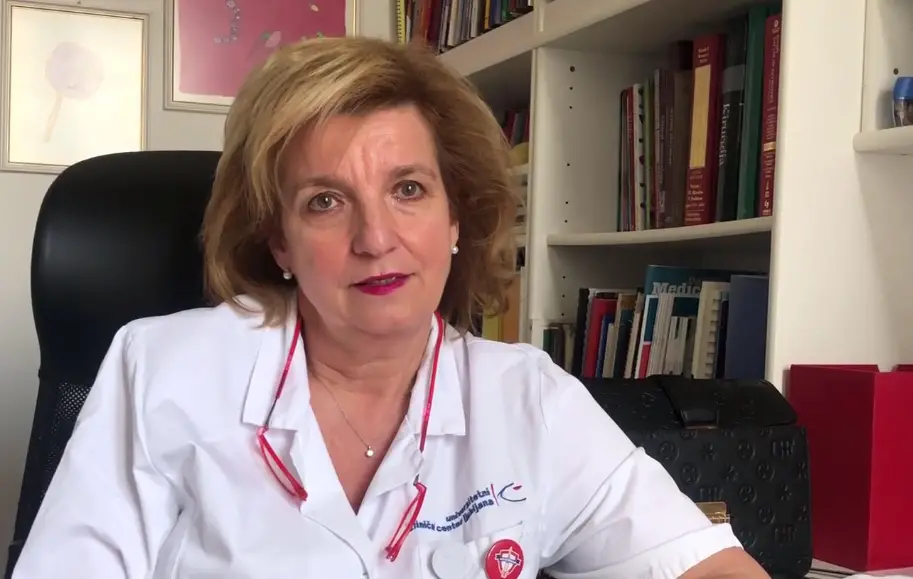
Bojana Beović. YouTube
Giving a statement for the press in a government briefing, she said that if the restrictions put in place will be effective, 480-680 people will still require hospital care in the second half of October, of them between 80 and 190 will require intensive care.
Currently, some 300 Covid-19 patients are in hospital in Slovenia, 60 requiring intensive treatment. Data collected by epidemiologists suggest that the main culprit for the contagion in the country are social events, she said. Foreign studies meanwhile suggest that the virus spreads most efficiently in bars, restaurants and in sports facilities.
Beović also commented as to why Slovenia faced a lack of intensive care unit (ICU) staff. The doctors and nurses working there require special skills and know-how, she said. At the same time, patients who are not infected with Sars-CoV-2 are also in ICUs and have to be cared for by the same teams as Covid-19 patients.
Touching on the most recent government measures, Beović underlined that the new restrictions had been based on expert criteria and were similar to those in other countries.
"In an ideal situation, we would have hoped that simple measures would suffice. But that has not worked, maybe also because we did not believe they would and did not stick to them."
The latest statistics on coronavirus and Slovenia, and the latest police news on red, green and yellow list countries. All our stories on coronavirus and Slovenia. Can I transit Slovenia? Find out from the police... All our stories on Slovenia and coronavirus
STA, 19 October 2020 - Below is a timeline of major events since the first case of coronavirus was confirmed in Slovenia in March 2020.
4 March - The first case of coronavirus infection is confirmed in Slovenia.
6 March - The government bans all visits to hospitals and nursing homes.
7 March - Public events in indoor spaces for more than 500 people are banned. A total of 12 infections confirmed in the country.
10 March - The government bans public gatherings indoors for more than 100 people and arrivals of flights from risky areas.
11 March - Slovenia introduces controls on the border with Italy; entry is allowed only at six checkpoints under certain conditions. Healthcare institutions suspend non-urgent preventive services.
12 March - Slovenia declares an epidemic of the novel coronavirus as almost 100 cases are confirmed. Kindergartens and schools close and primary and secondary school students switch to remote learning. Shops with non-essential goods, restaurants and bars are closed, as well as cultural institutions and libraries. Air passenger transport is suspended and public passenger transport is banned, except with taxis. Non-urgent medical services are suspended. All sporting events are cancelled. The border with Italy is closed for cargo transport and for international railway and bus passenger transport, with some exceptions.
18 March - Slovenia closes 27 local border crossings with Croatia, and only four checkpoints remain on the border with Italy. Many production companies temporarily suspend their work.
20 March - A general ban on gatherings and movement in public spaces, with some exceptions, enters into force.
20 March - The National Assembly passes the first package of measures to help the economy.
30 March - A decree limiting the movement of people to within the municipality of one's residence, with certain exceptions, enters into force.
2 April - The National Assembly passes the first anti-corona legislative package designed to help the affected companies and individuals. The measures were estimated at EUR 3 billion.
11 April - With the first signs of the epidemic waning, suspension of non-essential specialist medical services is lifted.
18 April - Maintenance and seasonal work on private land outside one's municipality of residence is allowed under certain conditions. Some sport and recreational activities are allowed within one's municipality of residence. A few days later, certain shops and service workshops are reopened.
28 April - The National Assembly passes the second anti-corona stimulus package, which includes state guarantees for liquidity loans to companies.
30 April - Exactly one month after being introduced, the ban on leaving one's municipality of residence is lifted. Visits to nursing homes are allowed, and a day earlier, cultural institutions and libraries re-open.
4 May - After several weeks, service is allowed in outdoor areas of restaurants and bars. Churches and some non-food shops, as well as hairdressers and beauty parlours reopen.
9 May - All healthcare and dental services are allowed again.
11 May - Public transport is re-launched after eight weeks, while international passenger transport continues to stand still. International air passenger transport is relaunched a day later.
15 May - The mandatory quarantine for Slovenian citizens and citizens of other EU member states upon entry in Slovenia is lifted. It remains in force for citizens of third countries.
18 May - Preschools reopen and children in the first three grades of primary schools and of the final grade of secondary school return to school. All shops and accommodation facilities with up to 30 rooms are allowed to reopen, and restaurants and bars are able to serve guests indoors as well.
18 May - The government creates lists of red, yellow and green countries relative to their epidemiological situation.
23 May - A majority of sports activities are relaunched, except in fitness centres and similar facilities.
25 May - Students of the final grade of primary school are allowed to attend school in person, while nursing homes and other social security institutions start accepting new residents.
26 May - A decree mandating a 14-day quarantine for citizens of EU member states and third countries enters into force, except for the green-listed countries.
29 May - The National Assembly passes the third anti-corona stimulus package, worth EUR 1 billion. The main measures are subsidies for shortened working time and tourism vouchers for facilities in Slovenia for all citizens. Subsidies for furloughed workers are extended.
31 May - After 80 days, the Covid-19 epidemic is officially declared over, as the daily number of infections drops below ten.
1 June - Students of the 4th and 5th grades of primary school return to school, and the number of children in units in primary schools and kindergartens no longer needs to be limited. Public events for up to 200 persons are allowed and all hotels, fitness centres and swimming pools are allowed to re-open. Night clubs remain closed.
3 June - Students of grades 6-8 of primary school return to school, while students of grades 1-3 of secondary school finish their school year remotely.
5 June - Austria is put on the list of countries from where entry is possible without limitations.
15 June - Public gatherings of up to 500 people are allowed. The restrictions on the border with Italy, introduced on 12 March, are lifted. International road and railway passenger transport is relaunched two days earlier.
19 June - The tourism voucher scheme enters into force, with the Financial Administration (FURS) transferring credit to all residents - EUR 200 per adults and EUR 50 per minor.
22 June - After two months of single-digit number of new daily cases, a double-digit daily number is recorded for the first time, mainly involving cases imported from abroad.
4 July - The government removes Croatia, France and the Czech Republic from the green list. Slovenia records a total of around 200 active infections.
9 July - The National Assembly confirms a new anti-coronavirus stimulus package with an emphasis on job preservation, mostly by extending subsidies for furloughed workers. A mobile contact tracing app is introduced. Gatherings of up to 10 people are banned, and gatherings of up to 50 persons are allowed only if the attendees are registered. Religious ceremonies and sporting events for up to 500 participants are still allowed.
18 July - A Covid-19 death is recorded for the first time after 31 May to increase the overall death toll in Slovenia to 112.
21 July - EU leaders agree on a pandemic recovery package, under which Slovenia may count on EUR 10.5 billion, including EUR 6.6 billion in grants.
23 July - The government adopts a new national plan for protection and rescue of people in the case of pandemic based on the experience with Covid-19. Restrictions on working time of food shops are lifted and stores are allowed to open Sundays.
25 August - Due to a deteriorating epidemiological situation in Croatia and the fact that many infections are imported from there, the government introduces quarantine for travellers returning from that country.
1 September - The new school year starts normally at all levels, albeit with number of precautionary measures in place.
2 September - A jump in new daily cases is recorded (55), and the number of active cases increases to around 500. Two days later, the government orders mandatory use of face masks and hand sanitation in public indoor spaces.
10 September - The daily number of new infections exceeds 100 for the first time, and the trend of a fast increase in the number of new cases starts. Infections start spreading in nursing homes and educational institutions.
13 September - The government reduces the mandatory quarantine upon entry from red-listed countries from 14 to 10 days.
19 September - Face masks are again mandatory in open public spaces where a large number of people gather, for example, at food markets. Employers are recommended to measure body temperature of employees, and opening hours of restaurants and bars are restricted to 6am-10pm.
29 September - The government adopts a new anti-coronavirus legislative package introducing new and extending the existing measures focusing on job preservation, care for the elderly and prevention of the spread of infections.
9 October - New restrictive measures enter into force. Gatherings are restricted to up to 10 people, and events with up to 500 people are allowed only with a permit from the health authorities, and held without food and drink served. Service in restaurants and bars and the number of shoppers in shops is limited.
12 October - A decree enters into force under which no country in the EU or the Schengen Area is on the green list.
15 October - The total number of confirmed cases in Slovenia exceeds 10,000, and a day later a record daily number of new cases (almost 900) is recorded.
16 October - Almost all statistical regions are classified as red zones based on epidemiological parameters, meaning that movement from and between them is banned. Face masks become mandatory in the open and gatherings of more than 10 persons are prohibited. Restaurants and bars are closed and certain sport activities are suspended in these regions.
19 October - An epidemic is declared once again, and the national protection and rescue plan is activated. Primary school students up from and including the 6th grade and secondary school students switch back to remote learning.
All our stories on coronavirus and Slovenia
I have far too many textbooks for learning Slovene. I’m not talking about dictionaries, of which I have more than 10, and enjoy adding to in used book stores, or guides to the grammar (3), but those books that take your hand and present the language step-by-step with vocab, grammar, readings, listenings, exercises and so on. A way to pull it all together, pass the A2/B1 test (for nationality) and put you on the path to independent learning by doing, fluency and never having to buy another textbook again.
And truth be told, while there are excellent dictionaries and grammars, until recently I didn’t have a textbook I’d recommend to anyone. They’re all OK, but none of them do what a new book from Rada Lečič does, the last Slovene textbook I hope to ever open, until volume 2 comes out.
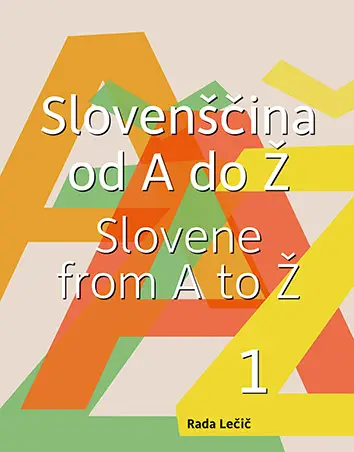
This is Slovene from A to Ž – Volume 1, the fruit of Lečič’s more than 30 years teaching the language to foreigners. As such it’s a comprehensive work that’s as useful for teachers as it is for students, with 10 units and almost 200 pages of well’planned, varied and interesting lessons and exercises that take you from saying hello to being able to pass the prized A1/B2 exam – if you do the work, of course.
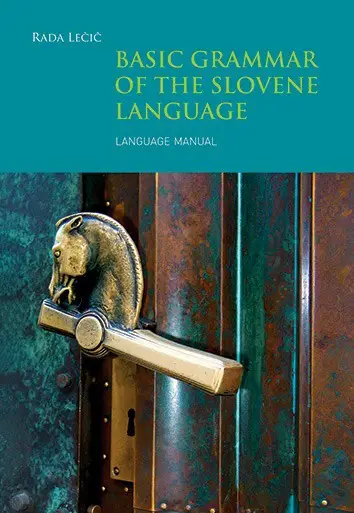
You might know Rada Lečič from some of her earlier works, notably the books on Slovene Verbs and Basic Grammar, which this volume obviously draws on.
Lečič has mostly worked with Italians, and thus the original version of the book was based on the lessons she gave to Italian speakers. But since the problems these face when learning Slovene are different to those of English of German native speakers she completely revised the text for those audiences (as seen, for example, in the different reflexive verbs used).
Of course it starts here...
...but it ends up much further away, with the first nine (of 10) units appropriate for a one-year course.
The book – which you can now find in stores and also order online – is a genuine personal project, with Lečič involved in every stage of the design process, producing a fully coherent and cohesive work that’s as well made as it is written, with high quality paper and sewn binding that will stand up to repeated use and being thrown out the window when frustrated with skloni.
Nearly all the words in the book also appear in the glossary - a mini-dictionary to support your studies.
Other things to note:
- All texts in Slovene are also shown in English on the same page, and a full glossary is included at the end of the book. Much less fussing with dictionaries as you study.
- Each unit introduces the focal vocab and grammar, and only that, then sticks with that for the readings, listenings and exercises, drilling it into your head.
- Grammar (including the declensions) is introduced slowly, without overwhelming the user, and with 10 pages of grammatical tables at the end of the book .
- Accent marks are shown throughout, a rarity on the scene, but also used in Lečič’s grammar and verb books.
- All the audio files are available online – no need to dig out a CD player.
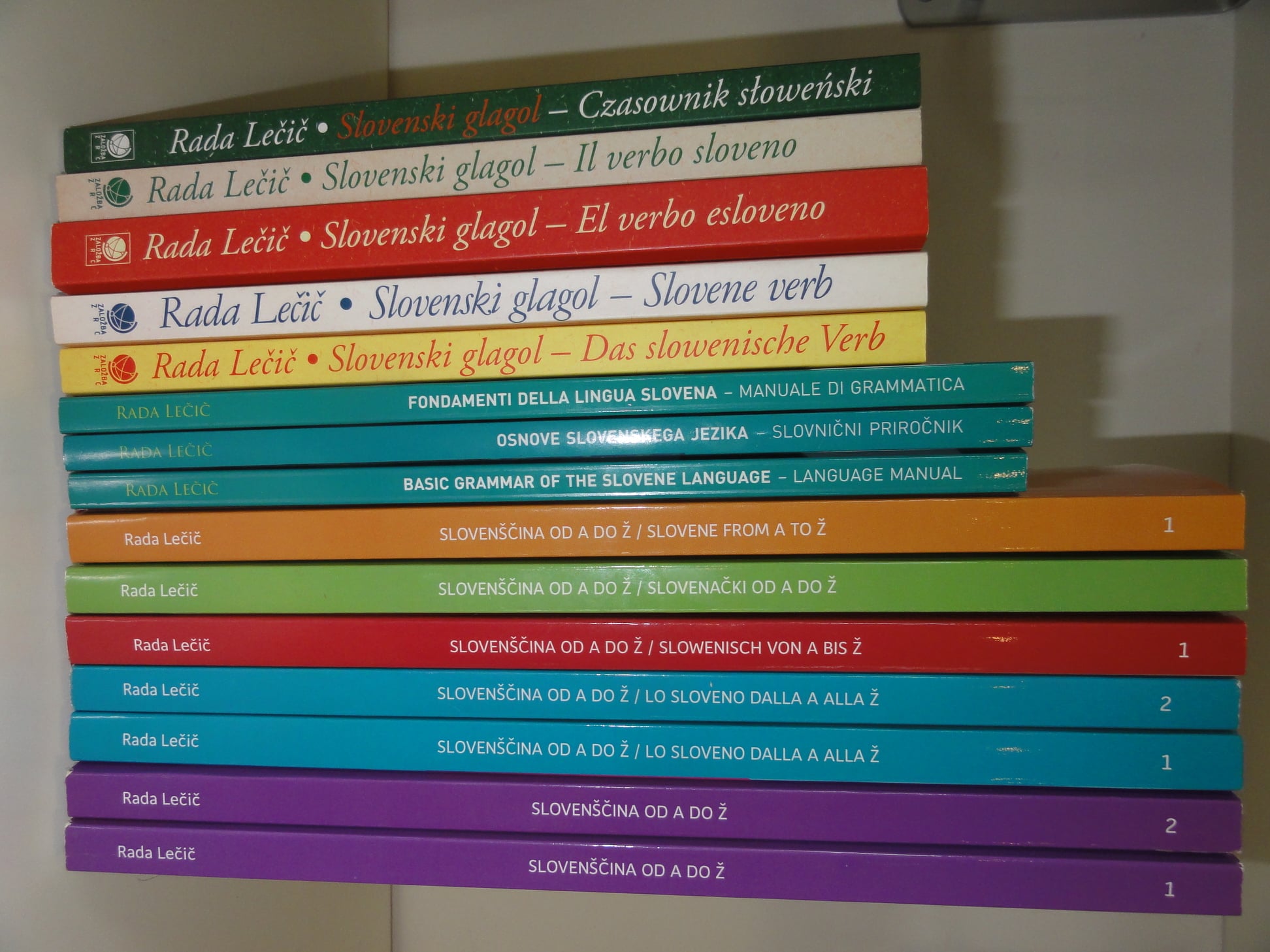
In short, Rada Lečič’s Slovene from A to Ž – available in English, Italian and German editions – is a top quality book that wasn’t rushed out to meet a deadline or tick a box. Instead it’s the result of decades of teaching the language, knowing how best to present things (and when) in order to set you up for success as you embark on the exciting, and often frustrating, journey of learning Slovene, no matter how many times it goes out the window.
STA, 6 October 2020 - Every fifth Slovenian was a victim of sexual abuse as a child, shows a recent survey commissioned by the Justice Ministry. Minister Lilijana Kozlovič announced on Tuesday that a bill enabling the country's first Barnahus for child victims of sexual abuse would be likely passed in 2021.
Slovenia has been striving to ensure a way for children involved in criminal procedures to avoid any potential victimisation in the future, said Kozlovič at today's press conference.
A step closer to this objective is setting up Children's House, a special institute where children who have been victims of sexual abuse or other criminal offences or have witnessed them would be treated holistically in line with the internationally established Barnahus model.
The project encompasses more than simply opening a few special facilities for child victims of sexual abuse; it also aims to amend relevant procedures and change attitudes of all who come in contact with abused children, the minister said.
As part of the project, which is held under the auspices of the European Commissions and the Council of Europe, the ministry also commissioned the survey, which aimed to assess the understanding of the issue among children themselves as well as adults and their response mechanisms to sexual abuse.
The results will serve as a way to provide services at Children's House which would be tailor-made for children and their parents.
The survey, conducted by the Ipsos social research institute, shows that the majority of Slovenians (almost 70%) think that child sexual abuse is a grave issue, however half of the respondents do not believe they would recognise the signs of such offences.
What is even more concerning is that many apply a very narrow definition to child sexual abuse. A third believe that it always involves a level of physical force and do not deem other types of sexual abuse what they actually are - sexual abuse.
A quarter of Slovenians also believe that exposing children to sex and pornography is not abuse, warned Nataša Mohorč Kejžar, the head of Ipsos.
Moreover, sexual abuse is a topic that Slovenians prefer to avoid - more than third of adults have not discussed it with their children, with most of them expecting schools to address the subject.
Another cause for concern is that 15% of the respondents think that victims are responsible for their actions. They perpetuate the harmful stereotype of a girl who is to be blamed for being abused due to the clothes she wears or her conduct.
One in five Slovenians experienced at least one type of sexual abuse in childhood, whereas one in seven experienced two or more.
In most cases, the respondents said that they had been victims of inappropriate touching or displays. Merely 6% pressed criminal charges, half of those went to court. One in four such cases saw trial without conviction, said Mohorč Kejžar.
The survey also inquired about the expectations for Children's House. Children mostly wish it would be a place where their stories would be heard and believed, whereas parents expect a safe space, professional services and immediate support.
Both children and parents deem it important that psychological support is available as well as support by the police and other health workers.
The minister said today that a facility which is to host Slovenia's first Barnahus had already been selected. She also pointed out that another project setting up a network of support centres for children in general across the country would follow the Barnahus project.
Mirka Honko of the Council of Europe's Children's Rights division meanwhile expressed support for Slovenia's Barnahus project, calling it a flagship project in Europe and hoping it would inspire other member states to follow suit.
The full report on child abuse in Slovenia can be read here


